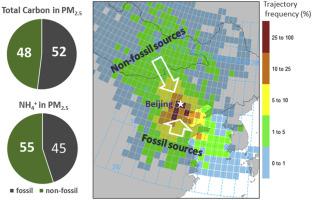Environmental Pollution ( IF 8.9 ) Pub Date : 2020-07-06 , DOI: 10.1016/j.envpol.2020.115163 Saehee Lim 1 , Xiaoyang Yang 2 , Meehye Lee 1 , Gang Li 2 , Yuanguan Gao 2 , Xiaona Shang 1 , Kai Zhang 2 , Claudia I Czimczik 3 , Xiaomei Xu 3 , Min-Suk Bae 4 , Kwang-Joo Moon 5 , Kwonho Jeon 5

|
Measuring isotopic ratios in aerosol particles is a powerful tool for identifying major sources, particularly in separating fossil from non-fossil sources and investigating aerosol formation processes. We measured the radiocarbon, stable carbon, and stable nitrogen isotopic composition of PM2.5 in Beijing (BJ) and Changdao (CD) in the North China Plain (NCP) from May to mid-June 2016. The mean PM2.5 concentrations were 48.6 ± 28.2 μg m−3 and 71.2 ± 29.0 μg m−3 in BJ and CD, respectively, with a high contribution (∼66%) from secondary inorganic aerosol (SIA; NO3−, NH4+, and SO42−).
The mean δ13C of total carbon (TC) and δ15N of total nitrogen (TN) values differed significantly between the two sites (p-value of <0.001): −25.1 ± 0.3‰ in BJ and −24.5 ± 0.4‰ in CD and 10.6 ± 1.8‰ in BJ and 5.0 ± 3.1‰ in CD, respectively. In BJ, the average δ15N (NH4+) and δ15N (NO3−) values were 12.9 ± 2.3‰ and 5.2 ± 3.5‰, respectively. The ionic molar ratios and isotopic ratios suggest that NO3− in BJ was formed through the phase-equilibrium reaction of NH4NO3 under sufficient NH3 (g) conditions, promoted by fossil-derived NH3 (g) transported with southerly winds. In BJ, fossil fuel sources comprised 52 ± 7% of TC and 45 ± 28% of NH4+ on average, estimated from radiocarbon (14C) analysis and the δ15N and isotope mixing model, respectively. These multiple-isotopic composition results emphasize that PM2.5 enhancement is derived from fossil sources, in which vehicle emissions are a key contributor. The impact of the coal source was sporadically noticeable. Under regional influences, the fossil fuel-driven SIA led to the PM2.5 enhancements. Our findings demonstrate that the multiple-isotope approach is highly advantageous to elucidate the key sources and limiting factors of secondary inorganic PM2.5 aerosols.


























 京公网安备 11010802027423号
京公网安备 11010802027423号